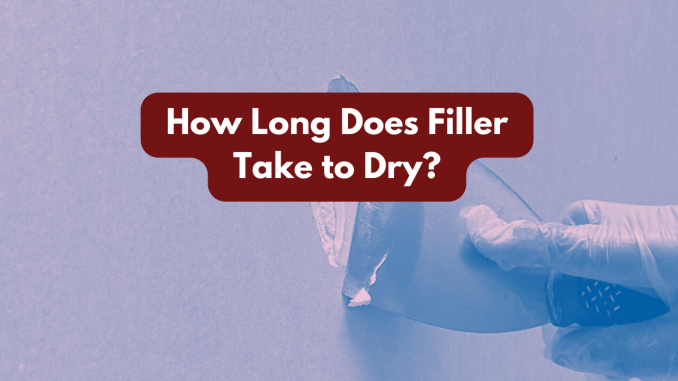
The drying time for filler can vary depending on factors such as the type of filler used, the thickness of the application, humidity levels, and temperature. Typically, most fillers will dry within a few hours to overnight. However, it’s essential to follow the manufacturer’s instructions on the product you’re using, as drying times can differ significantly between different types of fillers. Additionally, some fillers may require multiple coats, with drying time between each coat.
Fillers can be made from a variety of materials, depending on their intended use and the specific properties required. Here are some common types of fillers and the materials they are typically made of.
How long does Plaster Filler take to dry?
Plaster filler, also known as patching plaster or joint compound, is a type of filler commonly used in construction and home improvement projects. Plaster fillers should be dry after about one hour, although drying times may differ depending on the product, so it’s essential to consult the label. Once touch dry, you can either apply a second layer if necessary or allow it to dry fully for 24 hours before sanding and applying additional finishes as needed.
Overall, plaster filler is a versatile and essential product for repairing and finishing interior surfaces in residential and commercial buildings.
How long does Wood Filler take to dry?
Wood filler typically dries within 2 to 6 hours, depending on factors such as the type of filler, the thickness of the application, humidity levels, and temperature. However, it’s important to refer to the specific product’s instructions, as drying times can vary. Some wood fillers may require longer drying times, while others may dry more quickly. After applying the wood filler, allow it to dry completely before sanding or applying any finishes.
How long does Spackle take to dry?
Spackle typically dries relatively quickly, often within 30 minutes to 1 hour for small repairs or thin layers. However, drying times can vary depending on factors such as the thickness of the application, humidity levels, and temperature. In some cases, it may take up to 2 hours or more for thicker applications to fully dry. It’s essential to follow the manufacturer’s instructions on the specific product you’re using to ensure proper drying and optimal results. After the spackle has dried completely, you can sand it smooth and proceed with painting or other finishing steps as needed.
How long does Metal Filler take to dry?
Metal fillers, such as those used for automotive repairs, typically have a drying time similar to other types of fillers. Depending on the specific product and conditions, metal filler can dry within a few hours to overnight. However, it’s crucial to consult the manufacturer’s instructions for the particular metal filler you’re using, as drying times can vary based on factors such as temperature, humidity, and thickness of the application. After applying the metal filler, allow it to dry completely before sanding or further finishing.
Overall, the composition of filler materials can vary widely depending on their intended application and performance requirements. Manufacturers may also incorporate additives, pigments, or other ingredients to enhance the properties and usability of the filler product.
Can you paint over filler?
Yes, you can paint over filler once it has dried completely. Once the filler is dry and sanded smooth, it provides a suitable surface for painting. Here are the general steps to paint over filler:
Allow the Filler to Dry Completely: Make sure the filler is fully cured according to the manufacturer’s instructions before painting. This typically involves waiting for several hours or overnight, depending on the type of filler and environmental conditions.
Sand the Filler Smooth: Use fine-grit sandpaper to sand the filled area until it is smooth and level with the surrounding surface. This step is crucial to ensure a seamless finish.
Remove Dust: After sanding, wipe away any dust or debris from the surface using a clean, dry cloth or a tack cloth.
Prime (if necessary): Depending on the type of filler used and the surface being filled, you may need to apply a primer before painting. Some fillers may recommend using a specific primer to improve adhesion and ensure proper paint coverage.
Paint: Once the surface is prepared, you can proceed to paint over the filler using your chosen paint. Apply the paint evenly with a brush, roller, or sprayer, following the manufacturer’s instructions for application and drying times.
Apply Additional Coats (if necessary): Depending on the desired finish and the type of paint used, you may need to apply multiple coats of paint, allowing each coat to dry thoroughly between applications.
Finish: Once the paint has dried completely, you can apply any additional finishes or coatings as needed, such as clear coat or sealant, to protect the painted surface and enhance its appearance.
By following these steps, you can effectively paint over filler to achieve a seamless and professional-looking finish.

Leave a Reply